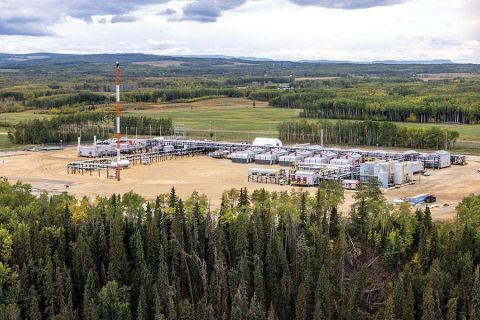The proliferation of production from shale gas has created a dichotomy for the natural gas storage industry and consumers. Logistical demand for storage is up, while price-driven demand is slumping. It's a clash between logistical need and price-volatility indifference, storage developers say.
Shale-gas producers need more storage so they can at least park production until it can be sold in the oversupplied market. But the influx of new shale-gas supply has created a commodity surplus and downward pressure on gas prices, making storage-price spreads less desirable, at least temporarily, according to Jeff Foutch, co-founder and managing director of Peregrine Midstream Partners LLC, Houston.
Peregrine owns Ryckman Creek Resources LLC, a gas-storage project under development that recently concluded a non-binding, oversubscribed open season for storage service at its proposed facility in Uinta County, Wyoming. The plan is to convert an existing, partially depleted oil and gas field into a 35-billion-cubic-feet (Bcf) working-gas storage facility.
Foutch says Peregrine did not specifically propose its Ryckman Creek Resources storage project in Uinta County, Wyoming, as shale-play infrastructure, but the project has certainly been influenced by shale production.

Icon NGS is developing the Tallulah Gas Storage project, a three cavern, 24-billion-cubic-feet salt cavern east of the Delhi Hub in northeast Louisiana. This well was drilled to test the brine-disposal zone.
The "shale-shocked" market, further stretched by a recession-driven demand slump, has resulted in an excess of gas, says Foutch. That surplus has lessened the immediate demand for storage as a hedge against price volatility, or as a physical hedge to ensure supply.
"The current mix of fundamentals has placed a downward pressure on gas-storage pricing, making it an ideal time for storage buyers to lock in long-term commitments at a very economical price," he observes. "This is a buying opportunity, because spreads won't remain depressed for long."
And he should know. Foutch, who has seen numerous cycles during his three decades in the gas industry, was also co-founder of Falcon Gas Storage—the largest independent gas-storage company in the U.S. when it was sold in 2010.
Meanwhile, the increased gas in storage, slack demand and increased shale production have kept seasonal spreads from widening. Ongoing low gas prices and tight basis spreads have made values for storage assets, in some instances, lower than when the project was conceived.
Today, the U.S. has about 3.8 trillion cubic feet (Tcf) of working-gas storage capacity. Yet, some 625 Bcf of new gas storage has been sought since 2007, spurred by shale-gas production.
In fact, nearly 200 Bcf of additional storage projects is pending before the Federal Energy Regulatory Commission, and another 45 Bcf of potential storage development is in the pre-filing stage. Not all of these projects will be developed, of course, but if even most of them are, it would represent a dramatic surge in storage capacity, considering that working-gas storage capacity only grew by about 0.60 Tcf since the beginning of 2006.
Pipelines and NGLs
Foutch estimates that about 50% to 60% of the storage projects in various stages of planning and development are being influenced by shale-gas production and the resulting increased pipeline buildout.
Yet, with shale production being spread across the U.S., it is difficult to estimate storage exactly. Shale gas is blurring the line between production-area and market-area storage. Foutch says he knows of no industry estimate, but suspects that liquids-rich shale production will significantly boost the need for natural gas liquids (NGLs) storage capacity.
Andy Lang, president and chief executive of Icon NGS LLC, agrees that at least in the near term, storage operators are challenged by a market that is seeing depressed spread-option values, although there are locations that have specific operational needs for storage.
Icon, also based in Houston, is developing the Tallulah Gas Storage project, a three-cavern, 24-Bcf salt-cavern project east of the Delhi Hub in northeast Louisiana. It is a portfolio company of QNGS Holdings, a joint venture of Larry Bickle and Quantum Energy Partners.
"There is still a need for additional storage assets, but only with a focus on location where new pipeline infrastructure has been built," Lang says. "Supply-driven pipelines, such as Rockies Express and the several pipelines serving the East Texas and Haynesville shale plays, have limited direct-access storage. These pipelines will need to have storage for competitive and operational reasons. It is no secret that access to as many pipelines as possible—for access to supply as well as to markets—is an integral strategy for storage-project success."

"As the shale-gas plays continue to develop, I believe the need for storage will follow along." John Shelton, director of storage, NiSource Gas Transmission & Storage.
John Shelton, director of storage for NiSource Gas Transmission & Storage, also sees a boom in storage projects, especially to serve power-generation operators and where take-away is needed for NGLs.
"In addition to the gas-fired power-generation growth, there is a tremendous surge of interest in the various shale-gas developments. We are working closely with a variety of natural gas exploration and production companies to pair up our facilities with the natural-gas extraction business to extract value for all involved," he says.
Houston-based NiSource's storage business began in 1919, so 95% of its current storage was designed and developed between the 1930s and the 1970s. The company owns and operates 35 depleted gas-storage facilities in Ohio, West Virginia, Pennsylvania and New York. It operates and jointly owns, with Piedmont Natural Gas, the Hardy storage facility in West Virginia. Altogether, NiSource has working-gas storage capacity of more than 265 Bcf.
Shelton believes that storage will play a key role in efficiently balancing the newly found gas supply with the soon-to-be-increasing demand for power generation.
"As the shale-gas plays continue to develop, I believe the need for storage will follow along. Storage is and will continue to be the ultimate balancer in the supply-demand mismatch that will always exist in the marketplace," he says.
Just as the shale plays are creating regional shifts in the supplies of natural gas, there will be regional demand changes for gas storage. While the U.S. has more gas storage than most other countries, not all of it is in the right place, due to widespread shale-gas development.
Successful storage operators will be those who can effectively interconnect their own, or other, storage assets to create networks of storage efficiencies, says Shelton. The challenge is to use these storage facilities to continue to meet historical services, but also to perform with more flexibility.
"Historically, this storage was developed to meet the winter-season heating demand markets of the Northeast. Today, these demands still exist, but additional demands have surfaced with a summer-season power-generation load that is continuing to grow," Shelton says.
Another northern storage operator, this one based in Kansas City, Missouri, is Inergy LP, which operates a 78-Bcf storage business through four facilities. The Stagecoach facility, which is owned by Central New York Oil and Gas Co. LLC (CNYOG), with some 26.25 Bcf of capacity, is northwest of New York City, right on top of the Marcellus shale play. Inergy's Steuben facility, with 6.2 Bcf, is in Steuben County, New York, as is its Thomas Corners facility, with 7 Bcf. The firm's newest acquisition, the Tres Palacios project, boasts 38.4 Bcf and is in Matagorda County, Texas, adjacent to the Eagle Ford shale play.

"Over time, supply and demand will once again return to seasonal variability, volatility will increase and instantaneous consumption will beat the premium." Bill Moler, senior vice president, Inergy Midstream LLC.
Bill Moler, senior vice president for Inergy Midstream LLC, says that lower gas prices and less price volatility will help gas snag more market share.
"As shale-gas developments keep gas prices lower, and while price volatility is somewhat suppressed, I believe we will see a significant spike in demand coming from coal-fired conversions, industrial-demand increases and the development of new gas-fired generation—and even natural gas vehicles," says Moler.
"Over time, supply and demand will once again return to seasonal variability, volatility will increase and instantaneous consumption will be at a premium. Storage will be there to fill that void."
Looking for ancillary projects around an established footprint is the best way to gain storage efficiencies, he says. CNYOG just recently received certificate authority for its proposed North-South access project, and is the first storage operator to offer a firm wheeling service, Moler says.
"This transportation look-alike allows storage operators to wheel gas on a firm-delivery basis to those shippers who want to utilize the header system to get from point to point, but have no need for storage services," he says. "This creative service offering puts CNYOG in a unique position with its 26 Bcf of storage and interconnectivity with four pipelines."
Storage challenges
Although operators are enthusiastic about new opportunities in the gas-storage industry, they are aware that challenges, such as price spreads, new regulations and location constraints, must be overcome.
Storage value should not be limited to just the price spread, they say, and opportunity is ahead as the shipper community demands more flexibility, reliability and liquidity.
"Due to excess inventories and weak demand, seasonal price spreads and volatility are depressed, causing pricing for storage to be at recent low levels," says Lang. "However, spread-option values are only one component of the value proposition for storage. Reliability, pipeline efficiency and balancing are among several more significant value parameters. From the perspective of the cost of materials and labor, this is one of the better times to be building storage."
Meanwhile, storage developers agree that the industry is facing more regulatory hurdles as environmental groups seem more empowered under the Obama administration.
"Permitting projects has become more difficult as regulators are exercising greater investigation of project environmental impacts. Longer review periods and more stringent implementation requirements will likely become standard for receiving construction and operating permits from regulatory authorities," says Lang. Advanced planning and increased interface with regulatory agencies and permitting bodies will be required and could add to project costs.
Another challenge has been finding optimal locations for storage. Reservoir projects are challenged by finding appropriate reservoirs in the right location that have well-defined closures to ensure that there is no migration of stored gas. Mother Nature created the geology, which cannot be picked up and moved for convenience, quips Shelton.
"In our operating area, most of the storage facilities were developed in rural farm country," he says. "Today, more and more urban sprawl has brought population centers closer to physical storage sites, including the wells, compressor sites and other facilities. We consistently focus on protecting the integrity of our storage facilities by ensuring we have adequate buffer acreage around them, while remaining respectful of the needs of expanding communities nearby."
On the storage integrity front, the biggest challenge is with ever-encroaching activities, from surface construction to underground mineral extraction, in and around the surface locations of storage, he says. "New storage opportunities will always be out there. We've operated storage for 90 years and are still finding ways to operate more efficiently. Existing storage facilities may have to be modified to some degree to meet the demands of gas-fired power generation, but the opportunity for development will continue."
Storage gives the natural gas industry what the electric power grid does not have—a means to warehouse energy feedstock when demand is low, and then to call upon that feedstock when demand increases.

An engineer adjusts a glycol boiler at the Stagecouch Natural Gas Storage facility in upstate New York.
Long-term investment
Storage facilities are long-term investments with many decades of performance potential, say the operators, but many factors must be considered before project launch. Total-field measurement, wellhead measurement, fluid-management facilities, high-pressure flexibility, gas-flow regulation, property protection, acquisition of 3-D seismic for complex-reservoir situations and many other issues must receive adequate review and a thorough understanding of their added value, or lack thereof, to the storage asset. Lack of knowledge of the early stages of storage development can be detrimental down the road.
Still, with current technology, and significant planning and strategies for efficiency, storage facilities can perform vital functions for the energy industry that were not available, or needed, in the past.
"With the advent of independent gas-storage operators, i.e., those who operate storage facilities separate from long-haul pipeline systems," says Moler, "and the creation of market-based rate making, storage operators now compete for business. Unlike traditional single-cycle storage connected to long-haul systems, this new breed of storage fields has high deliverability and multipipe connectivity, giving shippers choice and liquidity.
"Shippers are no longer restrained by the seasonal limitations. In many instances, injections can occur on Monday and withdrawals occur on Tuesday. These facilities are perfect for local distribution companies' ever-changing balancing act of supply versus demand, and perfect for gas marketers who are trying to make money anywhere there is a spike in volatility."
Moler says that storage operators should "do a better job of selling the need for storage" as it relates to the physical nature of the business. Too many people tie the value of storage to intrinsic spreads in the forward curve, which should only represent a small portion of the value in the service, he says. Service offerings also include load balancing, short-term parks, and loans to avoid costly pipeline penalties, supply reliability, dependable market access and peaking services during critical periods.
Going forward, the growth in demand will likely be strongest from the power-generation sector, causing greater need for short-term balancing on pipelines. Also, many of the new alternative energy sources, such as wind and solar, will require quick-response, back-stop gas-fired generation. In the midterm, operators' plans for developing storage assets in the regions where gas-fired power generation is growing will support the efficient development of a larger market for natural gas.
Recommended Reading
E&P Highlights: Sept. 23, 2024
2024-09-23 - Here's a roundup of the latest E&P headlines, including Turkey receiving its first floating LNG platform and a partnership between SLB and Aramco.
As Rig Count Slips, Oil Production Keeps Growing
2024-10-22 - Despite the offshore rig market showing signs of demand slippage, oil production looks to be on the rise for the foreseeable future, Westwood analysts say.
With Montney Production Set to Grow, US E&Ps Seize Opportunities
2024-10-02 - Canada’s Montney Shale play has already attracted U.S. companies Ovintiv, Murphy and ConocoPhillips while others, including private equity firms, continue to weigh their options.
E&P Highlights: Sept. 16, 2024
2024-09-16 - Here’s a roundup of the latest E&P headlines, with an update on Hurricane Francine and a major contract between Saipem and QatarEnergy.
Baker Hughes Defies Nature with an Upgrade to Ol’ Fashioned Cement
2024-10-15 - Baker Hughes’ InvictaSet uses regenerative capabilities to provide operators with a sustainable cement solution that can last for years.
Comments
Add new comment
This conversation is moderated according to Hart Energy community rules. Please read the rules before joining the discussion. If you’re experiencing any technical problems, please contact our customer care team.




